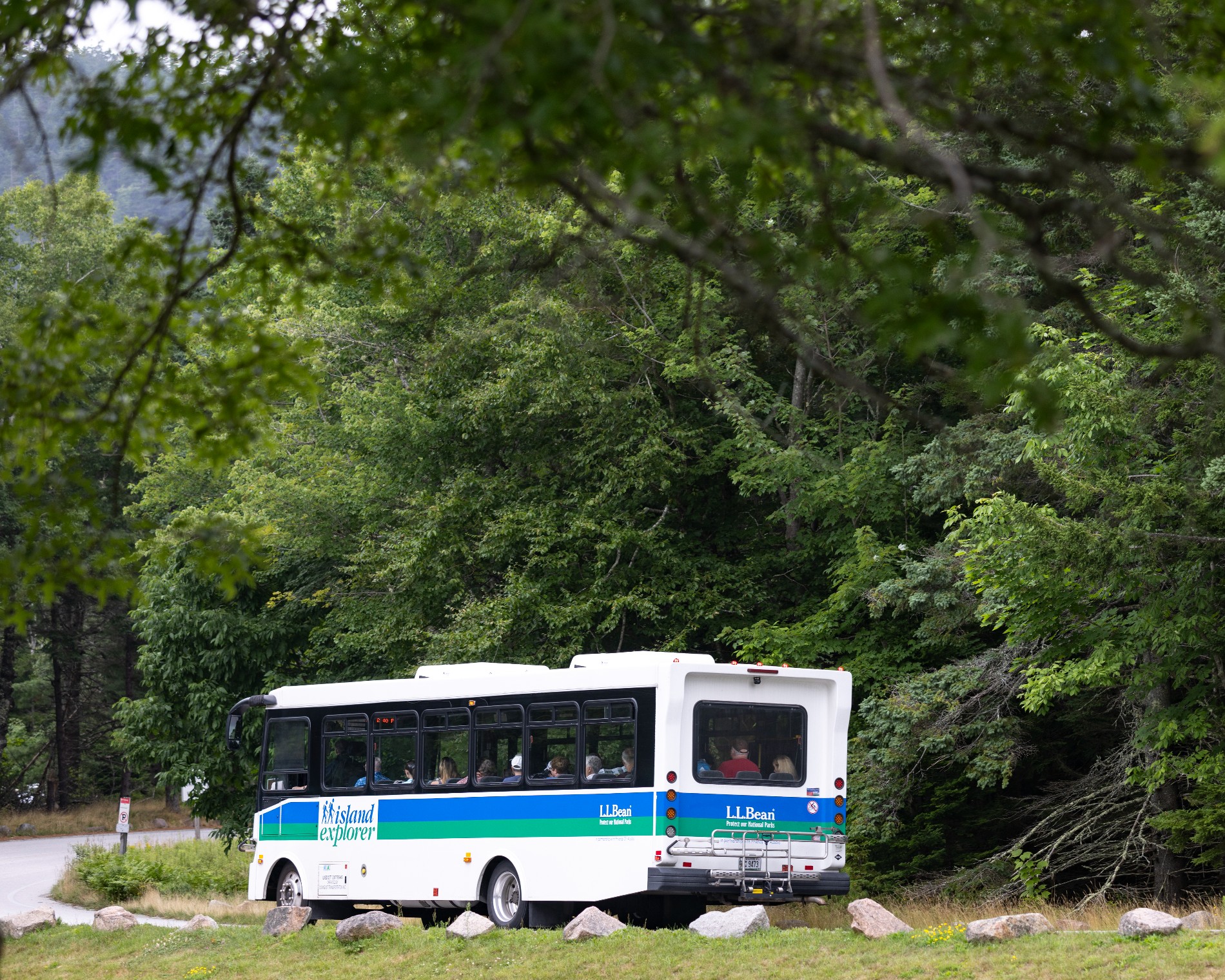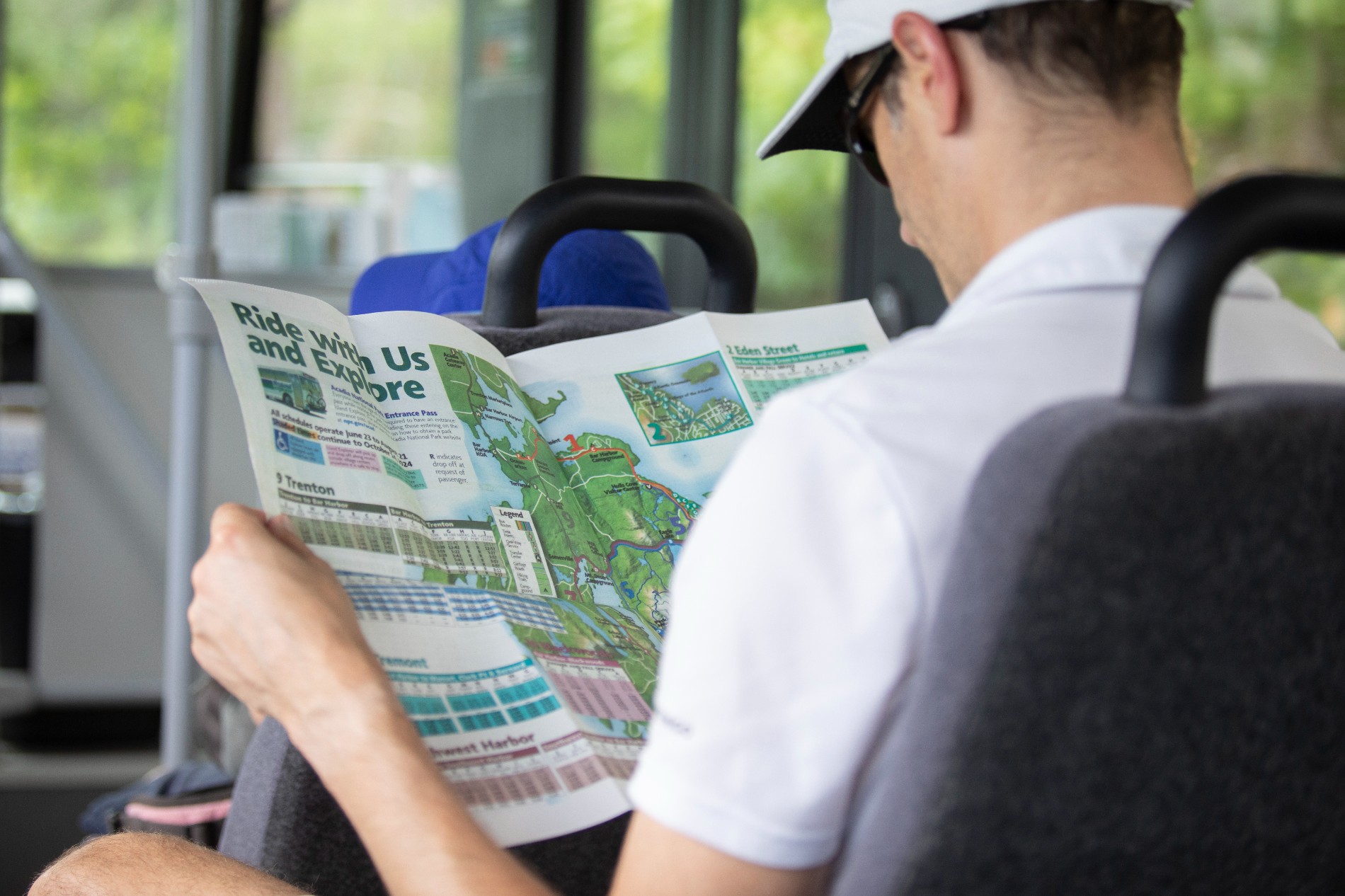A Route Forward
In its 25th year, the Island Explorer continues to show how national parks can cope with their growing popularity.
October 29th, 2024
In its 25th year, the Island Explorer continues to show how national parks can cope with their growing popularity.
October 29th, 2024
BY LYNN FANTOM
Before 1999, the Island Explorer ran one route, basically from local campgrounds near the head of Mount Desert Island, through downtown Bar Harbor and out to Sand Beach. It cost $2 a ride, according to Paul Murphy, executive director of Downeast Transportation, which still operates the service.
“We approached Friends of Acadia with an idea: if we could eliminate the fare, it would increase ridership. Friends of Acadia agreed to grant us $6,000 and ridership increased by 600 percent,” Murphy said. “We figured we were onto something.”
In fact, they had lift off, and in 1999 eight fare-free, propane-powered buses took off, thanks to a Congestion
Mitigation and Air Quality (CMAQ) grant from the U.S. Department of Transportation (DOT). Nine more buses hit the road the following year.
Now, as Island Explorer operates for the 25th season, it is entering a new era with plans to convert most of the bus fleet from propane to electric power and a realm of possibilities offered by the Acadia Gateway Center, which will open next spring. But its mission remains the same: to provide an alternative transportation system that serves residents, commuters, and visitors to Acadia National Park and its surrounding communities.

An Island Explorer bus drives on the Park Loop Road in Acadia National Park. (Evie Linantud/Friends of Acadia)
The Island Explorer has been clocking impressive numbers.
In 2023, ridership exceeded 450,000, eliminating over 160,000 car visits and preventing an estimated 1,600 tons of carbon dioxide from entering the atmosphere. The reduction in the number of autos has also meant better air quality for people with conditions like asthma.
On any given day from June to October, an Island Explorer bus might carry a family to a hiking trail or a summer resident to her job or a couple to the Bar Harbor farmers market to mosey around without having to worry about parking. Teens get to the beach without having to pester mom or dad for a ride.
“Just one of the 11 routes is solely within the park, so the Island Explorer not only serves tourists, it also significantly serves the community and the businesses around the park,” said John Kelly, management assistant at Acadia National Park.
In annual surveys, passengers praise the clean buses, helpful drivers, on-time service, and routes to the right destinations. This level of satisfaction was not easy to anticipate, though, especially among local residents.
“In the beginning, there was huge skepticism. People questioned, ‘All these buses rolling around the island; who’s gonna ride ‘em?’ It was just foreign to the community,” said Murphy. “But over the course of 25 years, that question has been turned on its head. And the question now is, ‘What would we do without that bus system?’”

An Acadia National Park visitor looks at the Island Explorer bus schedule and map while riding the Island Explorer bus. “Some people call us the L.L.Bean buses. And we’re quite happy with that. They’re a terrific organization to be associated with,” says Paul Murphy of Downeast Transportation. Since 2002, L.L.Bean’s contributions and pledges have totaled $5.5 million. (Evie Linantud/Friends of Acadia)
The vision for an island-wide transportation system actually dates back to 1992 and Acadia National Park’s general management plan. Said Kelly, “Acadia was one of the first national parks to identify the need for an alternative transportation system.”
If there was ever a “Father of the Island Explorer,” he continued, it was the late Len Bobinchock. As deputy superintendent of the park at the time, Bobinchock not only committed to using clean energy from the start but also conceived of a unique system design.
Instead of asking people to drive to centralized parking lots, he came up with the idea to pick them up where they were already parked—at their campgrounds and hotels. This “front-door service” increased the appeal of bus ridership, provided private funding from the hospitality businesses, and further reduced congestion.
Along with Bobinchock, Ken Olson was a driver of innovation, particularly by magnifying the private component to the funding model. In 2001, as president of Friends of Acadia, he approached L.L.Bean about a sponsorship. He wanted to go big, and the next year the outdoor retailer pledged $1 million, spread over a period of years.
Currently, Downeast Transportation derives 60 to 70 percent of Island Explorer’s annual operating budget from a portion of the park’s entry fees, $300,000 annually from the L.L.Bean grant, and the balance from the Federal Transit Administration, Maine Department of Transportation, local municipalities, businesses, and on-board donations from riders.
“The National Park Services derives all of its operational funding for the Island Explorer from park entrance fees rather than federal taxes,” Kelly said.
The year 2002 also marked another innovation: the test of an intelligent transportation system, including global positioning technology, real-time departure signs, and passenger counting.
Acadia was selected for the trial by the U.S. Departments of Transportation and the Interior, which had been working together on transit systems in national parks since 1997.
The new technology “contributed to a positive visitor experience and increased visitors’ willingness to use transit rather than their own vehicles,” according to an expert evaluation in 2003.
“It’s a fabulous tool,” said Murphy. No doubt it has helped make the Island Explorer “one of the most lauded transit systems—if not the most—in the national park system,” Kelly added.

An Island Explorer bus driver poses for a photo. (Evie Linantud/Friends of Acadia)
“Where’s the entrance to Acadia?” is a common refrain among first-time visitors who don’t realize that this national park was created through private donations of land interspersed among Mount Desert Island’s existing villages. But the new Acadia Gateway Center, scheduled to open in Trenton in the spring of 2025, will provide “a sense of arrival to the park,” said Kelly.
“By virtue of its architecture, this is not a building that visitors are going to pass,” Kelly said. Inside, they can get advice, find maps and books about Acadia and other destinations in Maine, and buy entrance passes. If visitors would like to leave their cars and board a bus, almost 300 parking spots will accommodate them. Plus, there will be electric vehicle chargers.
Planners envisioned the Acadia Gateway Center as a place with parking and a bus boarding facility that allows day-use visitors, commuters, and local residents to leave their cars and ride the Island Explorer. Maybe even more importantly, they see the opportunity to increase awareness of the Island Explorer’s convenience so visitors will use it once they’re settled in.
The location on Route 3 will also be the home base for a new fleet of 23 electric buses and charging stations—a major milestone resulting from a $23.5 million Rebuilding American Infrastructure with Sustainability and Equity program grant from the U.S. Department of Transportation last June. The grant is matched with $5.6 million from the National Park Service and $300,000 from Friends of Acadia to replace the propane buses and install bus charging stations, likely starting in 2027.
> See Acadia Gateway Center project updates
Though significant challenges limit the potential of Island Explorer—a shortage of bus drivers currently chief among them—generous financial support, evolving community attitudes, and lots of creativity are helping address them.
As the Island Explorer picked up its 10 millionth rider in September, Friends of Acadia Vice President Stephanie Clement takes stock of the last 25 years. “To me, the bus system is the best way to help people visit Acadia National Park—both to reduce the headaches of traffic and circling parking lots without finding spaces and also to reduce air pollutant emissions,” she said.
“I don’t know what this park will look like in 50 years, but public transportation is going to have to play a bigger role. And so, I’ve been thrilled with the investment that we’ve made throughout our current history and sure hope those who follow will do even more.” Stephanie said. “It’s all about the future.”

The Acadia Gateway Center exterior is still under construction but drawing nearer to completion. Island Explorer’s 25 years are marked with innovative sponsorships and leading-edge technology. The seasonal transit system is operated by Downeast Transportation, which also manages a year-round commuter bus service in Hancock County. (Photo by Julia Walker Thomas)
LYNN FANTOM is a former New York advertising executive who has embraced her second career as a freelance writer in Maine.